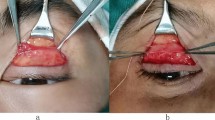Abstract
Objective
By comparing the position of the fusion point between the oriental orbital septum and the levator aponeurosis of the upper eyelid in Asian without and with mild ptosis, this study explores the relationship between the fusion point and mild ptosis, providing scientific basis for better utilizing the orbital septum to correct mild ptosis.
Methods
In this study, the outpatients who underwent double eyelid blepharoplasty with incision method in the plastic laser cosmetology department of Hunan Provincial People's Hospital from October 2018 to April 2019 were divided into the normal group and the mild ptosis group. The position of the fusion part of the orbital septum and the aponeurosis of the levator palpebrae superioris was observed in the two groups. There are three types of this position: the height of the fusion part is greater than the width of the tarsal plate, the height of the fusion part is equal to the width of the tarsal plate, and the height of the fusion part is less than the width of the tarsal plate. After the fusion part was exposed during the operation, the width of tarsal plate and the height of fusion part were measured with a scale. The difference of the location of fusion part between the two groups was analyzed.
Results
The tarsal plate width was 11.061 ± 0.635 mm in the normal group and 11.062 ± 0.675 mm in the mild ptosis group. There was no significant difference in tarsal plate width between normal group and mild ptosis group (t = 0.645, p = 0.16). The height of the fusion part was 11.032 ± 0.646 mm in the normal group and 11.645 ± 0.429 mm in the mild ptosis group. The fusion position of mild ptosis group was higher than that of normal group (t = 3.769, P < 0.05). There was significant difference in the distribution of fusion site between the two groups (x2 =38.00, P < 0.0001).
Conclusion
The height of aponeurosis fusion of orbital septum and levator palpebrae superioris in mild ptosis group was higher than that in normal group, which may be the cause of mild ptosis. It is suggested that the appropriate treatment of orbital septum in clinical operation may be effective in the treatment of mild blepharoptosis.
Level of Evidence III
This journal requires that authors assign a level of evidence to each article. For a full description of these Evidence-Based Medicine ratings, please refer to the Table of Contents or the online Instructions to Authors https://www.springer.com/00266.



Similar content being viewed by others
References
SooHoo JR, Davies BW, Allard FD et al (2014) Congenital ptosis. Surv Ophthalmol 59(5):483–492
Ouyang T-x, Xing X et al (2003) The role of releasing the fibrous bundles across levator muscle in correcting congenital blepharoptosis. Zhonghua Zheng Xing Wai Ke Za Zhi 19(3):186–187
Hwang K, Huan F, Kim DJ (2012) Levator sheath revisited. J Craniofac Surg 23(5):1476–1478
Pang NK, Newsom RW et al (2008) Fasanella-Servat procedure: indications, efficacy, and complications. Can J Ophthalmol 43(1):84–88. https://doi.org/10.3129/i07-181
Mercandetti M, Putterman AM, Cohen ME et al (2001) Internal levator advancement by Muller′s muscle- conjunctival resection: technique and review. Arch Facial Plast Surg 3(2):104–110
Li G, Ding W et al (2018) A new method for mild blepharoptosis correction using orbital septum. J Plast Reconstr Aesthet Surg 71(9):1362–1380. https://doi.org/10.1016/j.bjps.2018.05.049
Park JW, Kang MS, Nam SM et al (2015) Blepharoptosis correction with buried suture method. Ann Plast Surg 74(2):152–156
Nuhoglu F, Ozdemir FE, Karademir Z et al (2013) Levator function in blepharoptosis surgery. Facial Plast Surg 29(1):71–75. https://doi.org/10.1055/s-0033-1333835
Park DH, Jung JM, Song CH (2008) Anthropometric analysis of levator muscle function. Plast Reconstr Surg 121(4):1181–1187. https://doi.org/10.1097/01.prs.0000304236.11519.09
Hen X, Wang CH, Chen R et al (2017) Progress in diagnosis and treatment of traumatic orbital apex syndrome. Prog Mod Biomed 17(4):798–800
Ng DS, Chan E, Ko ST (2015) Minimal incision posterior approach levator plication for aponeurotic ptosis. Eye (Lond) 29(4):483–491
Jeong S, Lemke BN, Dortzbach RK, Park YG, Kang HK (1999) The Asian upper eyelid: an anatomical study with comparison to the Caucasian eyelid. Arch Ophthalmol 117(7):907–912. https://doi.org/10.1001/archopht.117.7.907. (PMID: 10408455)
Anderson RL, Beard C (1977) The levator aponeurosis. Attachments and their clinical significance. Arch Ophthalmol 95(8):1437–1441
Kim HS, Hwang K (2013) Double-eyelid surgery using Septoapon eurosis junctional thickening results in dynamic fold in Asians. PRS GO 1(2):1–9
Sayoc BT (1956) Absence of superior palpebral fold in slit eyes; an anatomic and physiologic explanation. Am J Ophthalmol 42:298–300
Meyer DR, Linberg JV, Wobig JL et al (1991) Anatomy of the orbital septum and associated eyelid connective tissues. Implications for ptosis surgery. Ophthal Plast Reconstr Surg 7:104–113
Miyake I, Tange I, Hiraga Y (1994) MRI findings of the upper eyelid and their relationship with single- and double-eyelid formation. Aesthetic Plast Surg 18:183–187
Kakizaki H, Leibovitch I, Selva D et al (2009) Orbital septum attachment on the levator aponeurosis in Asians: in vivo and cadaver study. Ophthalmology 116:2031–2035
Hwang K, Yoo SK, Kim DJ (2018) Location of the septoaponeurosis junction relative to the tarsal plate in upper eyelids. J Craniofacial Surg 1:1051–1053
Doxanas MT, Anderson RL (1984) Oriental eyelids: an anatomic study. Arch Ophthalmol 102:1232–1235
Funding
None
Author information
Authors and Affiliations
Corresponding author
Ethics declarations
Conflict of interest
The authors declare no competing interests.
Consent for Publication
Written consent has been obtained.
Additional information
Publisher's Note
Springer Nature remains neutral with regard to jurisdictional claims in published maps and institutional affiliations.
Rights and permissions
Springer Nature or its licensor (e.g. a society or other partner) holds exclusive rights to this article under a publishing agreement with the author(s) or other rightsholder(s); author self-archiving of the accepted manuscript version of this article is solely governed by the terms of such publishing agreement and applicable law.
About this article
Cite this article
Luo, Y., Chen, Q., Chen, X. et al. Comparisons of the Fusion Point of Orbital Septum and Levator Aponeurosis in Patients with and Without Mild Ptosis. Aesth Plast Surg 48, 829–834 (2024). https://doi.org/10.1007/s00266-023-03544-3
Received:
Accepted:
Published:
Issue Date:
DOI: https://doi.org/10.1007/s00266-023-03544-3




